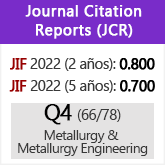Análisis de perfiles de difracción de una aleación Cu –2 % en peso Cr –6 % en peso Mo, aleada mecánicamente
DOI:
https://doi.org/10.3989/revmetalm.2008.v44.i3.112Palabras clave:
Aleado mecánico, DRX, Tamaño cristalito, Falta de apilamiento, Cu-Cr-MoResumen
A través del análisis de perfiles de difracción de rayos X es posible obtener información válida de la estructura y propiedades de los materiales. Es una poderosa herramienta para caracterización de microestructuras de materiales nanoestructurados. En el presente trabajo se preparó una aleación ternaria Cu -2 % Cr -6 % Mo (% en peso) mediante aleación mecánica de los polvos elementales con tiempos comprendidos entre 0,25 y 4 h. A través de las metodologías de Williamson-Hall, modificada, y Warren-Averbach, modificada, se determinó el tamaño de cristalitos, densidad de dislocaciones, microdeformación y distancia promedio entre dislocaciones. El tamaño de cristalitos fue corregido por la presencia de faltas de apilamiento. Se comprobó que los polvos poseen una alta deformación anisotrópica, que fue corregida haciendo uso de los factores de contraste promedio para estructuras fcc. Se determinó, además, la influencia del tiempo de molienda y porcentaje de soluto sobre la probabilidad de falta de apilamiento y energía de falta de apilamiento.
Descargas
Citas
[1] E. MA, Prog. Mater. Sci. 50 (2005) 413-509. doi:10.1016/j.pmatsci.2004.07.001
[2] C. Suryanarayana, Mechanical Alloying and Mill, Marcell Dekker, Primera edición, New York, USA, 2004, pp. 83-94.
[3] E. Gaffet, C. Louison, M. Harmelin y F. Faudet, Mater. Sci. Eng. A 134 (1991) 1.380- 1.384.
[4] Y. Ogino, S. Murayama y T. Yamasaki, J. Less Common Metals 168 (1991) 221-235. doi:10.1016/0022-5088(91)90304-M
[5] M. Barro, E. Navarro, P. Agudo, A. Hernando, P. Crespo y A. García-Escorial, Mater. Sci. Forum 235:238 (1997) 553-558.
[6] Y. Wang, M. Chen, F. Zhou y E. Ma, Nature 419 (2002) 912-915. doi:10.1038/nature01133 PMid:12410306
[7] C. Suryanarayana, G.E. Korth y F.H. Froes, Metall. Mater. Trans. A 28 (1997) 293- 302. doi:10.1007/s11661-997-0132-4
[8] J. García-Barriocanal, G. Garcés, P. Pérez y P. Adeva, Rev. Metal. Madrid 41 (2005) 281-290.
[9] T. Chen, J.M. Hampikian y N.N. Thadhani, Acta Mater. 47 (1999) 2.567-2.579.
[10] J. Gubicza, M. Kassem, G. Ribárik y T. Ungár, Mater. Sci. Eng. A 372 (2004) 115-122. doi:10.1016/j.msea.2003.12.016
[11] E. Schafler, G. Steiner, E. Korznikova, M. Kerber y M.J. Zehetbauer, Mater. Sci. Eng. A 410/411 (2005) 169-173. doi:10.1016/j.msea.2005.08.070
[12] F.H. Froes, C. Suryanarayana, K.C. Rissell y C.M. Ward-Close. Novel Techniques in Synthesis and Processing of Advanced Materials, proceeding of a Symposium. Illinois, 1994. The Minerals, Metals & Materials Society (TMS) and the Materials Information Society (ASM Internacional).
[13] T. Ungár. Scr. Mater. 51 (2004) 777-781. doi:10.1016/j.scriptamat.2004.05.007
[14] T. Ungár, J. Gubicza, G. Ribárik y A. Borbély, J. Appl. Crys. 34 (2001) 298-310. doi:10.1107/S0021889801003715
[15] I. Groma, Phys. Rev. B 57 (1998) 7.535-7.542.
[16] E.J. Mittemeijer y P. Scardi, Diffraction Analysis of the Microstructure of Materials Spinger Verlag Berlin Heidelberg, New York, EE.UU., 2004, pp. 249-285.
[17] T. Ungár y G. Tichy, Phys. Status Solidi A 171 (1999) 425-434. doi:10.1002/(SICI)1521-396X(199902)171:2<425::AID-PSSA425>3.0.CO;2-W
[18] C. Aguilar, S. Ordoñez, J. Marin, F. Castro y V. Martínez. Mater. Sci. Eng. A en prensa.
[19] B.E. Warren. X-Ray Diffraction, Dover Publications Inc., New York, EE. UU., 1990, pp. 251- 312.
[20] T. Ungár y A. Borbély, Appl. Phys. Lett. 69 (1996) 3.173-3.175.
[21] R. P. Reed y R. E. Schramm, J. Appl. Phys. 45 (1974) 4.705-4.711.
[22] W. Hertzberg, Deformation and Fracture Mechanics of Engineering Materials, Jhon Wiley & Sons. Tercera Edición, USA, 1989, p. 14.
[23] G.K. Williamson YW.H. Hall, Acta Metall. 1 (1953) 22-31. doi:10.1016/0001-6160(53)90006-6
[24] T. Ungár, I. Dragomir, Á. Revés, A. Borbély, J. Appl. Cryst. 32 (1999) 992-1.002.
[25] F. W. Gayle y F. S. Biancanello, Nanostruc. Mater. 6 (1995) 429-432. doi:10.1016/0965-9773(95)00088-7
[26] C. Aguilar, J. Marín, S. Ordóñez, D. Celentano, F. Castro y V. Martínez, Rev. Metal. Madrid 42 (2006) 334-344.
[27] K. Kapoor, D. Lahiri, I. S. Batra, S. V. R. Rao y T. Sanyal, Mater. Charact. 54 (2005) 131-140. doi:10.1016/j.matchar.2004.09.009
[28] P. Sahu y S.K. Pradhan, J. of Alloy. Compd. 377 (2004) 103-116. doi:10.1016/j.jallcom.2003.10.019
[29] C.N.J. Wagner y J.C. Hélion, J. Appl. Phys. 36 (1965) 2.830-2.837.
[30] W. Truckner y D.E. Mikkola, J. Appl. Phys. 40 (1969) 5.021-5.029.
[31] B.D. Cullity y S.R. Stock, Elements of X-Ray Diffraction, Third Edition, Addison-Wesley, 2001, p. 363.
[32] X.Nie, R. Wang, Y. Ye, Y. Zhou y D. Wang, Solid. State Commun. 96 (1995) 729-734. doi:10.1016/0038-1098(95)00506-4
[33] T. Ungár, Mater. Sci. Eng. A 309/310 (2001) 14-22. doi:10.1016/S0921-5093(00)01685-3
Descargas
Publicado
Cómo citar
Número
Sección
Licencia
Derechos de autor 2008 Consejo Superior de Investigaciones Científicas (CSIC)

Esta obra está bajo una licencia internacional Creative Commons Atribución 4.0.
© CSIC. Los originales publicados en las ediciones impresa y electrónica de esta Revista son propiedad del Consejo Superior de Investigaciones Científicas, siendo necesario citar la procedencia en cualquier reproducción parcial o total.Salvo indicación contraria, todos los contenidos de la edición electrónica se distribuyen bajo una licencia de uso y distribución “Creative Commons Reconocimiento 4.0 Internacional ” (CC BY 4.0). Puede consultar desde aquí la versión informativa y el texto legal de la licencia. Esta circunstancia ha de hacerse constar expresamente de esta forma cuando sea necesario.
No se autoriza el depósito en repositorios, páginas web personales o similares de cualquier otra versión distinta a la publicada por el editor.


















